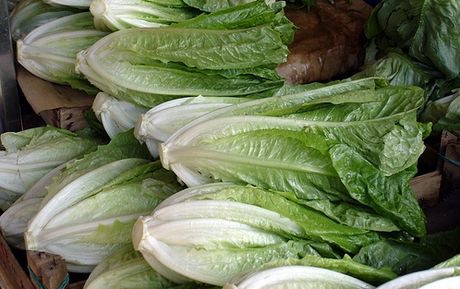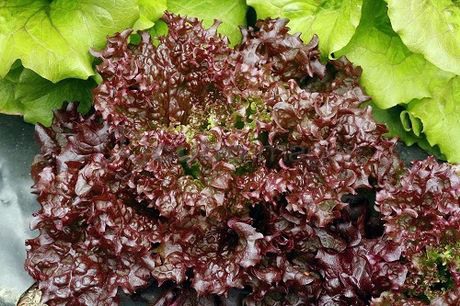Leafy vegetables grow in the field and can be contaminated by bacterial pathogens, such as E. coli and Salmonella, during growth, harvesting, and shipping. For these reasons, it is fundamental to follow the Good Agricultural Practices (GAP) to reduce microbial contamination risks and the sources of bacterial pathogens. However, contamination of leafy vegetables on the farm by bacterial pathogens can occur, and the contaminated produce in its turn will contaminate both the processing line and the other products in the processing plant. Thus, it is imperative that during the fresh-cut processing the initial microbial contamination must be effectively reduced to ensure the safety of the product.
Chlorine is the most widely used sanitizer in leafy vegetable washing because of its low cost and its efficacy against bacterial pathogens. However, like other oxidant sanitizers, chlorine efficacy decreases by increasing organic loads in washing water. Freshly cut lettuce can release copious amounts of vegetable latex into the water and rapidly deplete free chlorine, reducing its efficacy against pathogens.
Nuo and Luo (2010) tried to change the current fresh-cut lettuce processing sequence consisting of cutting followed by washing, into a sequence consisting of washing followed by cutting. The objective of their work was to demonstrate that chlorinated water wash before cutting can significantly improve pathogen reduction efficacy in comparison to a chlorine wash after cutting. Furthermore, the researchers showed that chlorine wash before cutting was effective to prevent pathogen cross-contamination during fresh-cut lettuce processing.
For the study, ‘Romaine’ and ‘Lollo Rossa’ lettuce (Lactuca sativa L.) were used. The lettuce heads were purchased from a produce wholesale market (Jessup, Md., USA) and stored at 5 °C overnight, before use the following day. ‘Romaine’ lettuce was used in the pathogen reduction study, while ‘Lollo Rossa’ and Green-leaf lettuce were mixed for the cross-contamination study. Both ‘Romaine’ and ‘Lollo Rossa’ lettuce were inoculated with E. coli O157:H7 strains.

Romaine lettuce.
The study consisted of two treatments. In the first treatment, the inoculated ‘Romaine’ lettuce leaves were sliced and then washed in chlorinated water (70 ppm of chlorine) for 1 minute, followed by a 2nd washing in chlorinated water for 30 seconds. In the second treatment, the inoculated ‘Romaine’ lettuce leaves were washed in chlorinated water (70 ppm of chlorine) for 1 minute and de-watered by centrifugation in a salad spinner, followed by cutting and a 2nd washing in chlorinated water for 30 seconds. To evaluate the effect of washing and cutting sequences on the pathogen cross-contamination, inoculated ‘Lollo Rossa’ lettuce leaves were mixed with freshly trimmed non-inoculated green-leaf lettuce leaves before subjecting them to two treatments as described above.

Lollo Rossa lettuce.
Results showed that both background microbial flora and inoculated E. coli O157:H7 strains were significantly reduced after washing in chlorinated water. This reduction was greater in the second treatment than in the first treatment (2.3 vs 1.7 log unit for background microbial flora). Washing whole ‘Romaine’ leaves in chlorinated water for 1 minute followed by slicing resulted in 1.9 log unit reduction, and a 2nd washing resulted in an additional 0.4 log unit reduction. Also for E. coli O157:H7, the second treatment was more effective than the first treatment in reducing the bacterial pathogen. Overall, chlorine washing prior to cutting resulted in 0.6 to 1.3 log unit higher reduction of E. coli O157:H7 than chlorine washing after cutting.
The sequence of cutting and washing significantly affected the water quality, in terms of free chlorine level reduction and total dissolved solids (TDS) increase. These parameters are more compromised in the first treatment (cutting before washing) than in the second treatment (washing before cutting). Free chlorine level
and TDS did not significantly change between the 1st and 2nd washing, this means that the 1st washing was sufficient to remove the majority of the latex responsible for the chlorine efficacy decrease.
Finally, washing leaves in chlorinated water before cutting reduced pathogen cross-contamination. When mixed leaves were cut before washing in chlorinated water, 97% of cross-contamination to non-inoculated green leaves by inoculated ‘Lollo Rossa’ leaves was observed. In contrast, when mixed leaves were washed in chlorinated water before cutting, 3.3% of cross-contamination of non-inoculated green leaves was observed.
Nou and Luo have demonstrated that washing whole leaves in chlorinated water before cutting improves the chlorine efficacy in wash and reduces the bacterial pathogen cross-contamination during both cutting and the following processing steps.
Original work. Nou X., Luo Y. "Whole-leaf wash improves chlorine efficacy for microbial reduction and prevents pathogen cross-contamination during fresh-cut lettuce processing", 2010, Journal of Food Science, No. Issue 75(5), pagg. 283-290. For more details: ucce.ucdavis.edu/files/datastore/234-1799.pdf
